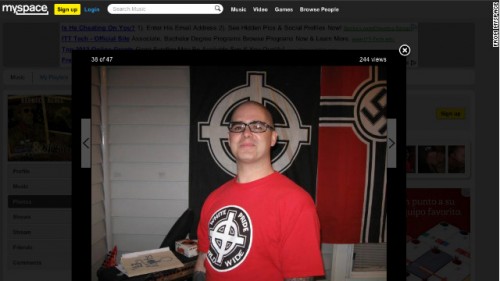The Sound of Hate
Share
Explore Our Galleries
Breaking News!
Today's news and culture by Black and other reporters in the Black and mainstream media.
Ways to Support ABHM?
By Robert Futrell and Pete Simi, New York Times
THE shooting rampage on Sunday that killed six people and wounded three others at a Sikh temple in Wisconsin exposed the continued dangers of white power extremism in our midst. The shooter, Wade M. Page, was affiliated with a range of neo-Nazi skinhead groups, and during the last decade, he played in several prominent bands in the white power music scene.
[…]
White power adherents are not typically “out” about their extremist leanings. They straddle the worlds of white power and mainstream society, often publicly playing down or hiding their extremist identities. In the past, this might have been a hindrance. But these days they thrive in what we call hidden spaces of hate, often online, where they gather to support one another and their cause.

Among the most important hidden spaces is the white power music scene. Neo-Nazis are particularly adept at incorporating music into just about every aspect of the movement, having grasped the medium’s capacity to bring adherents together into shared experiences and sustain communities anchored in Aryan ideology.
[…]
The music does more than convey anger, hatred and outrage toward racial enemies; like all music, it is heavy with emotions like power, pride, dignity, love and pleasure, which create a collective bond that strengthens members’ commitment to the cause.
Many white power music events are tightly controlled in ways that limit attendance to neo-Nazi sympathizers and keep them mostly hidden from public view. Organizing the events as “white-only, members-only” spaces is a calculated effort to create collective experiences where, at least momentarily, adherents can experience the world they idealize: where enemies of whites are vanquished and Aryans rule.
Read more here.
Read about a white power extremist and band leader in Wisconsin who became a teacher of peace and tolerance, here.









Comments Are Welcome
Note: We moderate submissions in order to create a space for meaningful dialogue, a space where museum visitors – adults and youth –– can exchange informed, thoughtful, and relevant comments that add value to our exhibits.
Racial slurs, personal attacks, obscenity, profanity, and SHOUTING do not meet the above standard. Such comments are posted in the exhibit Hateful Speech. Commercial promotions, impersonations, and incoherent comments likewise fail to meet our goals, so will not be posted. Submissions longer than 120 words will be shortened.
See our full Comments Policy here.